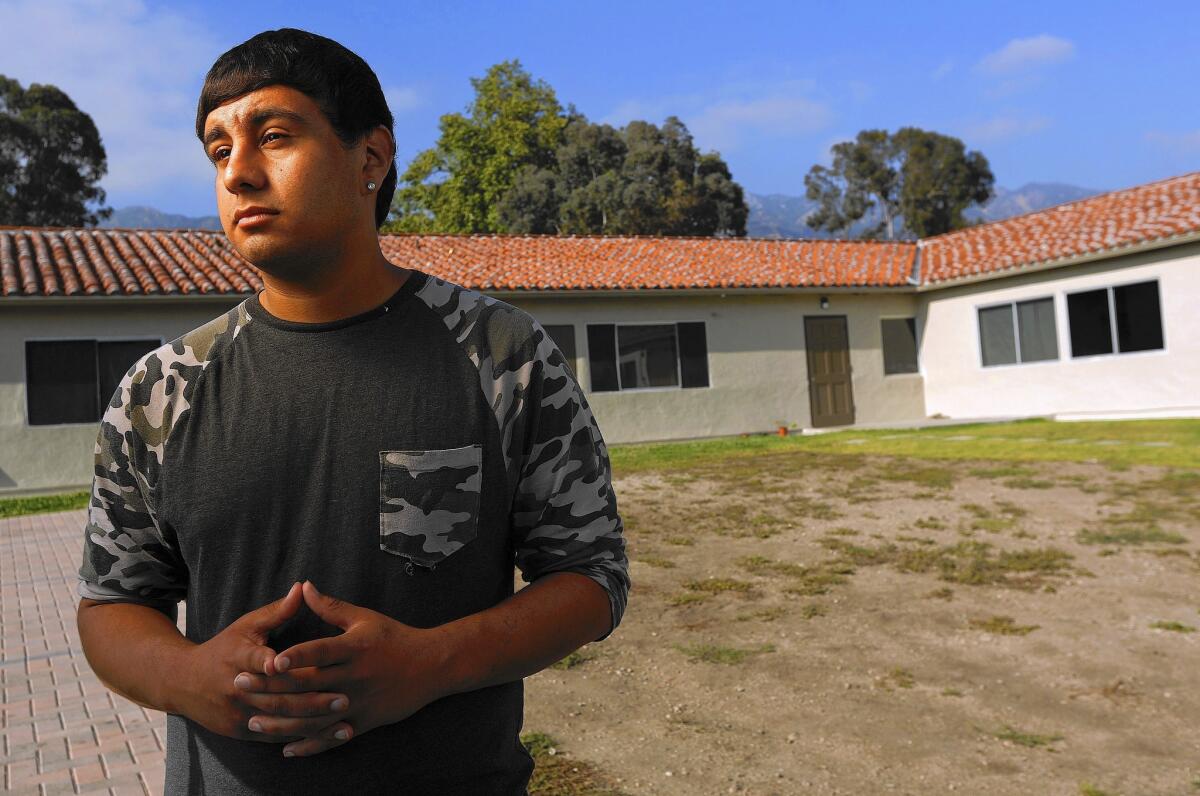Great Read: Jesse is a typical boy in probation-run foster care: unwanted

Jesse Opela is one of a small subset of foster kids whose cases are overseen by probation officers, not social workers.
Jesse Opela hunched on a plastic chair in the “music room” at Central Juvenile Hall, a cramped space with no air conditioning, an old CD boombox, a keyboard and a bookshelf filled with aging bestsellers. Tears rolled down the sturdy 17-year-old’s face as he apologized to his probation officer.
“I messed up everything,” Jesse said. “I had so many chances and I messed all of them up.”
Not too long ago, Jesse had dared to dream that he would be one of the lucky ones — not like most of the other kids in the probation-run foster care system.
For some of the most troubled young wards of the state, the chance of being adopted, or even placed in a foster home, once they’ve broken the law is near zero.
Jesse’s chances looked even smaller.
When he was 12, he said, he broke down a door and tried to kill the middle-aged woman who had adopted him when he was a toddler. He was sent to a residential treatment facility for teens with severe psychological or behavioral issues. Jesse said he was later diagnosed with bipolar disorder.
When he was 13, he said, he punched a police officer who was trying to detain him, leading to a charge of battery on a police officer. It was his first stay in juvenile hall — and the beginning of his years under the Los Angeles County probation system.
SIGN UP for the free Great Reads newsletter >>
“I just said … “F— it, ‘I have nothing to live for anyways — might as well act a fool. I guess this is my destiny to just be in jail all my life,’” he said.
Then, when he was 15, he landed at Dorothy Kirby Center, a probation facility for youths with mental health issues. He befriended Dwain Miller, a volunteer chaplain who had a grown adopted son and had sometimes opened his home to other children who had nowhere to go.
During one of his talks with Miller, Jesse asked whether the chaplain might be willing to adopt him. “Anything’s possible,” Miller said.
Jesse choked up.
“I took it to heart, thinking I finally have someone, I finally have somebody in my life, hoping that it might come true.”
------------
FOR THE RECORD:
Probation foster care: An article in Sept. 28 Section A about Los Angeles County foster children supervised by the probation department identified Jennifer Rodriguez as executive director of the Children’s Law Center of California. She is executive director of the Youth Law Center. —
------------
::
Jesse is one of a small subset of foster children whose cases are overseen by probation officers rather than social workers.
They’ve landed in the Los Angeles County Probation Department because they’ve been both neglected or abused and committed a crime. Most of them bounce back and forth between group homes and juvenile lockups until they turn 18.
Few are placed in foster homes, and adoptions are even rarer: Only seven such children have ever been adopted in California, despite stepped-up efforts by some probation agencies to find more permanent homes.
“We know that young people rehabilitate and heal in families. They don’t do that in institutions,” said Jennifer Rodriguez, executive director of the Children’s Law Center and herself a former “crossover kid.” “When we put children in this situation, it becomes impossible to expect that their behavior is going to do anything but get worse.”
The Times received unusual court permission to interview Jesse and track his often rocky trajectory through the system. In seven months, he will turn 18, and he will probably make his passage to legal adulthood in one of the same institutions where he has spent most of his adolescence.
::
Born to a drug-addicted mother, Jesse was taken from his birth parents when he was 2. He went to live in a foster home in Lancaster with a woman whose own children were grown. After several prospective adoptions fell through over the course of the next year, his foster mother adopted him.
But his new family unraveled when he neared his teens.
Jesse knows that many adults see him as a threat. But he said he’s “just a lost kid asking for help.”
Jesse said that his adopted mother was abusive and deprived him of basic childhood rites such as birthday parties and Christmas presents.
His adopted mother, Melodina Opela, a diminutive 68-year-old originally from the Philippines, denied that she had hit her son. She said she’d tried to give him a normal upbringing with family parties and snowball fights in the nearby mountains with her grandchildren and other foster kids, but that he had anger issues and she had lived in fear of his outbursts.
Opela said she won’t take her adopted son back — even if he wanted to return — because she’s worried about her safety and that of her young grandchildren. But she feels the loss.
“I miss him,” she said. “I still cry about him.”
::
About a decade ago, the county Probation Department began a push to find more permanent homes for youths like Jesse. At first, skeptical probation officers joked about printing bumper stickers that would say, “Adopt a criminal.”
But over the years, attitudes have started to change, along with a larger shift in thinking about juvenile justice that puts more emphasis on rehabilitating youths who have gotten in trouble.
“There’s much more of a shift in people seeing probation foster youth as having the same needs as foster youth that haven’t committed crimes,” said Lisa Campbell-Motton, who oversees the Probation Department program that searches for placements for the teens. “Those kids are very similar.”
As of July 31, 808 youths were in the probation foster system. Some started out as foster children and then committed a crime, earning them the nickname “crossover kids.” Others were first arrested and then landed in the foster system because officials found they didn’t have a safe home — or a home at all — to return to. Of those youths, 756 were living in group homes. Fifty-one more were placed with relatives, family friends or other adults who had been part of their lives. Only one was in a foster home.
By contrast, children in the normal foster-care system run by the Department of Children and Family Services are far more likely to be living with relatives or in foster homes.
A recent report by the California Department of Social Services emphasized the need to shift kids away from group home care, which it described as “not in the best interest of children and youth.”
An organization representing group home providers took issue with that characterization, saying that many youths have been helped by caring group home staff and placement decisions should be made based on each child’s circumstances, not on “general idealistic beliefs that do not always equate with reality or with the desires of the impacted youth.”
::
Jesse bonded more deeply with Miller after the chaplain told the boy he might be willing to adopt him.
Miller recalled, “It sort of blossomed — or maybe erupted would be a good term for it — from there.”
Jesse began calling Miller “Dad.” On Jesse’s 16th birthday, they had a party with root beer floats at Dorothy Kirby. Miller went through a home check and background check necessary for Jesse to visit him and perhaps eventually come to live with him. Jesse spent that Thanksgiving with Miller’s extended family.
But the arrangement began to unravel after Jesse left Dorothy Kirby and moved to a group home in Altadena. Jesse met a girl in school, and their relationship quickly became all-consuming. He became less interested in spending time with Miller. And then Miller’s adult son moved back in with him, taking the room that would have been Jesse’s.
With the potential adoption on the skids, probation officials began looking for other places to put Jesse.
At a court hearing in June, the judge decided that Jesse would stay at the group home in Altadena. But within a week, Jesse ran away with his girlfriend — twice. He got picked up by police in July — Jesse said he’d turned himself in after his girlfriend broke up with him — and was sent back to Central Juvenile Hall.
The return to the lockup threw Jesse into a depression. He hated seeing other kids get letters and visits from their families, while the only visits he got were from his probation officer.
“It hurts to have nobody, to look outside the room and see families just visiting, and all I can do is look outside and watch,” he said.
One day, Miller came to see him at the juvenile hall’s chapel. Miller’s son was still living with him, but he said he wanted to continue being part of Jesse’s life as a mentor. Jesse asked his probation officer whether he would be able to resume visiting with Miller upon his release back to the group home.
In part, Jesse’s fate may depend on where he is when he turns 18. If he’s in a group home or foster care placement, state law allows him to remain a foster youth until he turns 21, providing extra support and money. But the benefits won’t be available if he’s in juvenile hall on his 18th birthday.
Jesse insisted that this time he’s ready to start taking the steps to stay out of trouble. He said he wants be a police officer — or maybe a probation officer.
“All my life has pretty much been wasted. Nothing I can do about it, really,” he said. “I know five years from now I’ll look back at it and say, ‘I’m glad I’m in a better place right now.’”
ALSO
Why 18 Orange County kindergartners are learning Vietnamese and English
Asians to surpass Latinos as largest immigrant group in U.S., study finds
Central Valley sees hope in Rep. Kevin McCarthy’s potential rise
More to Read
Sign up for Essential California
The most important California stories and recommendations in your inbox every morning.
You may occasionally receive promotional content from the Los Angeles Times.











